Water-Efficient Landscape Gardens in November
Home » Fair Oaks Horticulture Center » WEL Gardens » November in the WEL
The WEL gardens at the Fair Oaks Horticulture Center are open to the public seven days a week from sunrise to sunset for self-guided tours.
Wheelchair accessible, the gardens feature natives, commonly available perennials, trees, shrubs, and plants from other Mediterranean climates that do well with less water during our long, hot, dry summers and tolerate our chilly, damp Sacramento County winters. Most plants are labeled and many are UC Davis Arboretum All-Stars. The landscape demonstrates how home gardeners can be smart about using the water we have to create beautiful landscapes. (For more information see Gardening with Limited Water.)
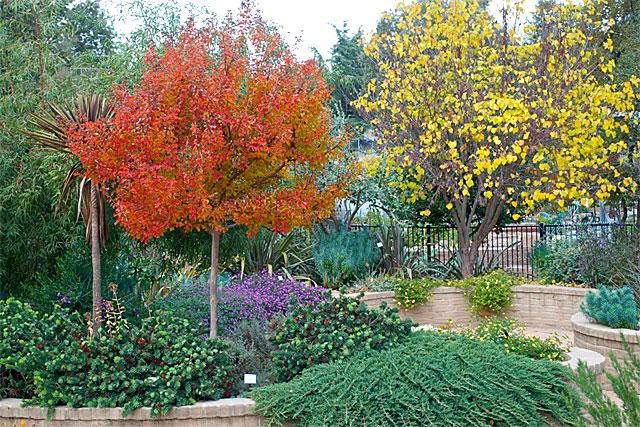
Days are shorter, nights are cooler, the sun is lower in the sky, and the rain has washed off the garden so that everything sparkles during the ever-changing November days. Cooler, shorter days are waking the native plants from summer dormancy. Manzanitas, ceanothus, currants, toyon, and mahonia all are sporting fresh new growth. Deciduous plants are bowing into winter with flashy orange and crimson leaves, while the back-lit golden ornamental grass inflorescences wave in cool breezes. Diverse foliage on our evergreen shrubs, grasses, perennials and trees sparkles in the rain-freshened air. Scarlet, crimson, gold and orange leaves on the scarlet oak, Chinese pistache, crape myrtles, Trident Maple, and winged Euonymus alatus (aka Burning Bush) remind us that we are now in November. But, surprising white, yellow, purple and pink accents are everywhere. Late blooming blossoms continue to attract birds, bees and other beneficials. Especially lovely now are the yellow copper canyon daisies and purple, red and blue autumn sages. Pink muhlygrass and purple Mexican sages continue to shine in the parking lot beds. Dwarf pomegranates and the dwarf strawberry tree concurrently display attractive red fruits and blossoms. Red ‘Little John’ bottlebrush along the raised entrance bed contrasts with the white, yellow and lavender lantanas and sages stretching out their blooms to the first frost.
In early November, while the earth is still warm, we will plant our newest additions to the garden in order to give young roots a head start on spring and summer. November is an especially good time to plant bulbs. We have many daffodils, narcissus, brodiaea, and species tulips throughout the garden. Check out our plant lists for details on a few of our favorites. These bulbs are all very drought tolerant as they prefer little or no summer water. Download our Garden Note on bulbs (PDF). November is also a good time to plant California native annual seeds such as poppies. California poppies benefit from a long fall/winter growing period that allows for strong root development ahead of the summer dry season. If happy, California poppies will aggressively reseed annually. In fact, all the lovely poppies in our garden came from one packet of seeds spread over 10 years ago.
November garden tasks include turning off the irrigation after checking the lines for leaks, continuing to monitor for newly sprouting weeds and cleaning debris out of our dry creek beds to allow for the filtering of rain water into the ground. November is also the time we prune back the goldenrod, and green mound juniper and cut California fuchsia to the ground.
In addition to the plants, pathways, patios, raised planters, drip irrigation, a dry creek bed and permeable pavement demonstrate water wise, sustainable alternatives for gardeners who are considering replacing or reducing their lawns.
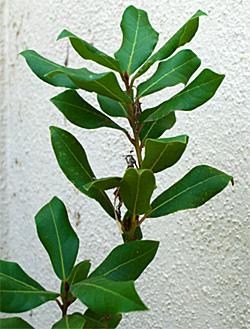
|
Laurus nobilis As the weather cools, many of us start cooking stews, soups, stuffings and stocks. A favorite culinary flavoring is the aromatic (thanks to the essential oil ceneole), fragrant leaf of the Mediterranean Laurus nobilis also known as sweet bay or Grecian laurel. The leaves of this evergreen, versatile tree, multi-trunked shrub, container plant, hedge or topiary can be harvested year round. Historically a garden and culinary favorite, ancient Greeks made garlands and crowns from the branches and leaves to honor bravery, victory and heroics. The commonly used phrases “resting on your laurels”, poet laureate and baccalaureate also originated from old Greek roots. Sweet bay is a member of the primarily tropical Lauraceae family, which includes avocados, cinnamon, camphor and the California native bay laurel, Umbellularia californica (which can also be used as a flavoring agent, but is not as popular). Bay laurels grow well in Sacramento with some afternoon shade to protect from sunburn. Not overly picky about soils, they do prefer well drained, slightly acidic locations. Small bay trees do well in pots due to their slow growth but can reach 20 to 40 feet tall in landscapes. Easy to propagate from seeds (flowers are insignificant and berries are often overlooked) or cuttings and forgiving of shearing, pruning and hedging they make a good choice for local gardens. Although very water-wise, a deep watering every 2 to 3 weeks in the summer will help the tree maintain vigor. If you are unfamiliar with the tree come visit the WEL where it is located along the fence bordering the community garden in the Mediterranean climate entrance garden. There is also a smaller tree in the herb garden. |
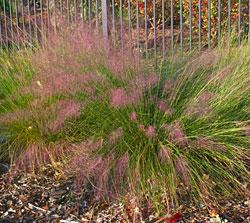
|
Muhlenbergia capillaris For most of the year, this warm season mounding ornamental grass is just another evergreen background plant. But, in late summer and early fall just as other summer blooms fade, an otherwise nondescript evergreen grass takes center stage in the FOHC parking lot bursting with show stopping persistent, vibrant, gauzy, pinkish-red, waving panicles rising up to 2 feet above the thin dark green mounding leaves. It is guaranteed to grab attention as visitors enter the front gate. Muhlenbergia capillaris, pink muhly grass, is native to Mexico and the eastern United States. Thriving in sun to part shade, it copes well with our hot, dry climate with some summer water and good drainage. Growing to 2 feet by 2 feet prior to bloom the dark green, slender leaves make a good background for spring and early summer perennials and annuals. The long lasting blooms dry into a light buff color throughout winter until February when we prune the entire plant down to 4 to 6 inches just prior to new spring growth. (Find additional information about this and other ornamental grasses seen in the WEL and elsewhere in Sacramento.) |
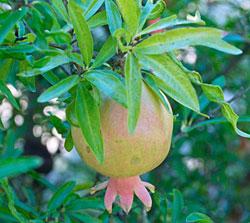
|
Punica granatum ‘Nana’ Pomegranates, which are natives of Northern Africa, Iran, Afghanistan, and the Himalayas, have been in California since the 1770s. Featured at the entrance to our "Commonly Available" garden area, this dwarf variety bears fall ripening fruit that is primarily decorative. It is generally evergreen in Sacramento. Tolerant of many soil types, including alkaline soils, heat and cold, and drought tolerant, it makes a good foundation shrub, hedge, accent or small tree. ‘Nana’ grows to 3 feet high by 6 feet wide. |
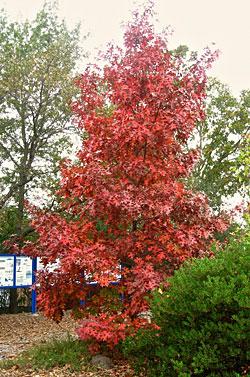
|
Quercus coccinea |
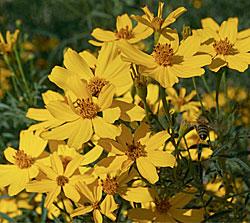
|
Tagetes lemmonii 'Compactum' Also known as tangerine scented marigold, this large shrubby herbaceous perennial originates in canyons at elevations between 4,000 to 6,000 feet from southern Arizona throughout Mexico. A member of the sunflower family, it is covered in the fall with vibrant, yellow daisy-like flowers that attract bees and other pollinators. The very aromatic, airy foliage can cause dermatitis so care should be taken when pruning. We have 2 varieties in our garden, one that reaches 6 to 8 feet in height and a dwarf variety that grows to about 4 feet tall. Both can reach 4 to 6 feet in width. Copper canyon daisy prefers good drainage and is drought tolerant. In fact, it blooms more abundantly when not overwatered. Blooms are triggered by shorter days in fall, so an overcast period earlier in the year may produce some additional bloom. If overwatered or given too much shade, the plant may become leggy. Hedging back the stems may reduce subsequent flower production, however. Fall blooms cover the bush and last until frost. Plants will die back in winter under frost conditions. We have found that our plants do best when cut back close to the ground just as spring growth begins. |



